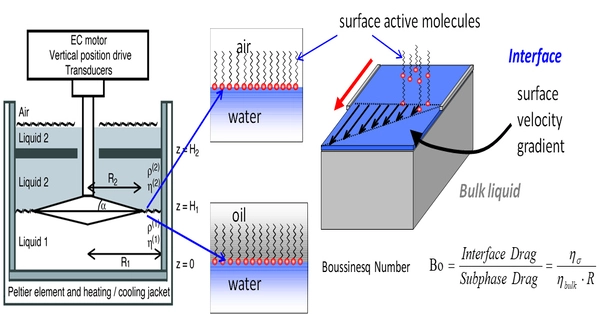Interfacial rheology is a branch of rheology that studies the flow of matter at the interface between a gas and a liquid or at the interface between two immiscible liquids. It is a branch of rheology that deals with the study of mechanical properties and behavior of interfaces between different phases of matter, such as liquid-liquid or liquid-gas interfaces. The measurement is done while having surfactants, nanoparticles or other surface active compounds present at the interface. Unlike in bulk rheology, the deformation of the bulk phase is not of interest in interfacial rheology and its effect is aimed to be minimized. Instead, the flow of the surface active compounds is of interest.
The deformation of the interface can be done either by changing the size or shape of the interface. Therefore interfacial rheological methods can be divided into two categories: dilational and shear rheology methods. It focuses on the characterization and understanding of the flow and deformation of these interfaces under the influence of external forces.
The mechanical properties of interfaces play a crucial role in various industrial and natural processes. For example, in the food industry, the stability and texture of emulsions and foams are determined by the rheological properties of the interfaces involved. In the oil and gas industry, the behavior of surfactant films at the oil-water interface affects the efficiency of oil recovery processes. In biological systems, the viscoelastic properties of cell membranes are important for cellular processes and interactions.
Advantages
Interfacial rheology involves the measurement and analysis of interfacial tension, surface elasticity, and surface viscosity. Various experimental techniques are employed to study these properties, including the pendant or sessile drop method, Langmuir trough, and oscillating droplet or bubble methods.
Interfacial rheology is also closely related to the study of surfactants, which are molecules that accumulate at interfaces and lower the interfacial tension. Surfactants can form monolayers or multilayers at the interface, and their rheological behavior affects the stability and properties of the interfacial films.
Theoretical and computational models are used to understand and predict the interfacial rheological behavior. These models often consider the effects of interfacial tension, surface elasticity, and viscosity on the deformation and flow of interfaces. The results obtained from these studies help in the design and optimization of processes involving interfacial phenomena, such as emulsification, foam formation, and wetting.
Overall, interfacial rheology provides valuable insights into the mechanical properties of interfaces and their impact on various industrial, biological, and environmental processes.
















